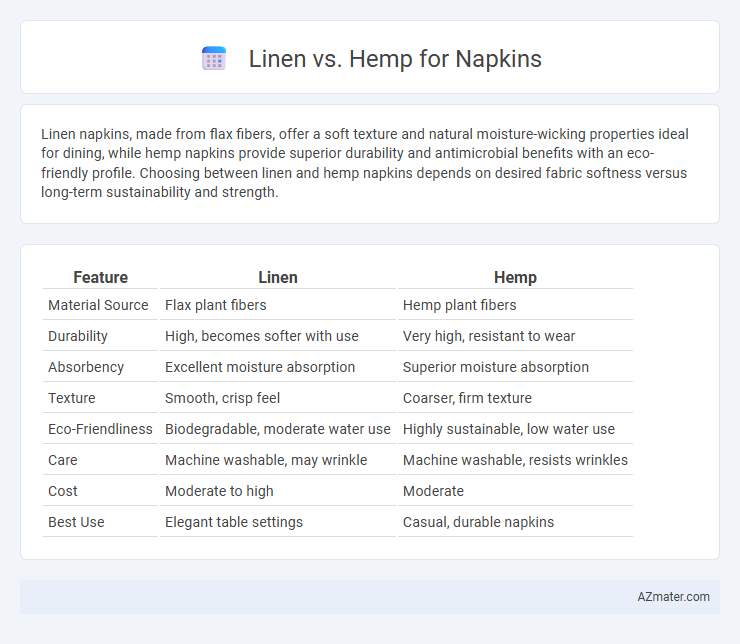Linen napkins, made from flax fibers, offer a soft texture and natural moisture-wicking properties ideal for dining, while hemp napkins provide superior durability and antimicrobial benefits with an eco-friendly profile. Choosing between linen and hemp napkins depends on desired fabric softness versus long-term sustainability and strength.
Table of Comparison
| Feature | Linen | Hemp |
|---|---|---|
| Material Source | Flax plant fibers | Hemp plant fibers |
| Durability | High, becomes softer with use | Very high, resistant to wear |
| Absorbency | Excellent moisture absorption | Superior moisture absorption |
| Texture | Smooth, crisp feel | Coarser, firm texture |
| Eco-Friendliness | Biodegradable, moderate water use | Highly sustainable, low water use |
| Care | Machine washable, may wrinkle | Machine washable, resists wrinkles |
| Cost | Moderate to high | Moderate |
| Best Use | Elegant table settings | Casual, durable napkins |
Introduction to Linen and Hemp Napkins
Linen napkins, crafted from flax fibers, offer exceptional durability, absorbency, and a smooth texture ideal for both casual and formal dining settings. Hemp napkins, made from the industrial hemp plant, provide natural antibacterial properties, high strength, and eco-friendly sustainability. Both materials present excellent alternatives for reusable napkins, combining functionality with environmental benefits.
Origin and Production Processes
Linen napkins derive from flax plants, cultivated primarily in Europe and Asia with a history dating back thousands of years, involving harvesting, retting, and scutching to extract fibers. Hemp napkins originate from the hemp plant, known for its durable fibers grown mainly in China, Canada, and the US, processed through decortication and retting to separate fiber from the stalk. Both materials undergo spinning and weaving, but hemp's faster growth cycle and less intensive pesticide use make it a sustainable alternative to traditional linen.
Environmental Impact Comparison
Hemp napkins have a significantly lower environmental impact than linen due to their faster growth rate and minimal need for pesticides or herbicides, making hemp a more sustainable crop. Linen, derived from flax, requires more water and intensive processing, contributing to higher resource consumption and greenhouse gas emissions. Both fibers are biodegradable and durable, but hemp's efficient cultivation leads to less soil depletion and reduced carbon footprint in textile production.
Texture and Feel of Linen vs Hemp
Linen napkins offer a smooth, soft texture with a natural sheen that becomes softer with each wash, providing a luxurious feel against the skin. Hemp napkins feature a coarser, more rugged texture that feels sturdier and more durable, ideal for everyday use with an earthy appeal. Both fabrics are breathable and highly absorbent, but linen's finer fibers lend it a more refined and elegant touch compared to hemp's rustic robustness.
Durability and Longevity
Hemp napkins are renowned for their exceptional durability due to their strong fibers, which resist wear and tear better than most natural fabrics. Linen napkins, made from flax fibers, also offer impressive longevity, becoming softer with each wash while maintaining strength. Both materials provide eco-friendly options, but hemp's robust texture typically outlasts linen in high-frequency usage.
Absorbency and Functionality
Linen and hemp napkins both offer high absorbency, but hemp fibers absorb moisture more quickly and hold greater amounts of liquid, making them ideal for heavy spills. Linen napkins provide excellent durability and softness while maintaining strong absorbent properties, suitable for everyday use and formal settings. Hemp's natural antimicrobial qualities enhance functionality by reducing bacteria build-up, adding a hygienic advantage over linen in napkin applications.
Design Versatility and Aesthetic Appeal
Linen napkins offer exceptional design versatility with their smooth texture and subtle sheen, making them ideal for both casual and formal settings. Hemp napkins provide a natural, rustic aesthetic with a coarser texture that lends an eco-friendly and organic appeal to table settings. Both fabrics support diverse dyeing and printing techniques, but linen's refined finish often enhances intricate patterns and vibrant colors more effectively.
Care, Maintenance, and Washing
Linen napkins require gentle washing in cold water and mild detergent to preserve their softness and prevent shrinking, often benefiting from air drying or low heat tumble drying to maintain fabric integrity. Hemp napkins offer higher durability and resistance to wear, tolerating frequent machine washing and higher temperatures without losing strength, though they may stiffen and benefit from occasional ironing to soften fibers. Both fabrics gain increased softness with repeated washing, but linen demands more delicate care, while hemp excels in resilience and low-maintenance durability.
Price Differences and Value for Money
Linen napkins typically cost more than hemp napkins due to the labor-intensive processing and the premium quality associated with flax fibers. Hemp napkins offer a more affordable option while providing durability and sustainability, often making them a better value for money for eco-conscious consumers. Price differences can range from 20% to 50%, with hemp napkins delivering solid longevity despite the lower upfront cost.
Choosing the Best Napkin Fabric for You
Linen napkins offer exceptional softness and absorbency, making them ideal for elegant dining settings, while hemp napkins provide superior durability and eco-friendliness, perfect for everyday use. Considering factors like texture, longevity, and environmental impact helps in selecting the best napkin fabric. Choosing between linen and hemp napkins depends on personal preference for comfort or sustainability.

Infographic: Linen vs Hemp for Napkin
 azmater.com
azmater.com